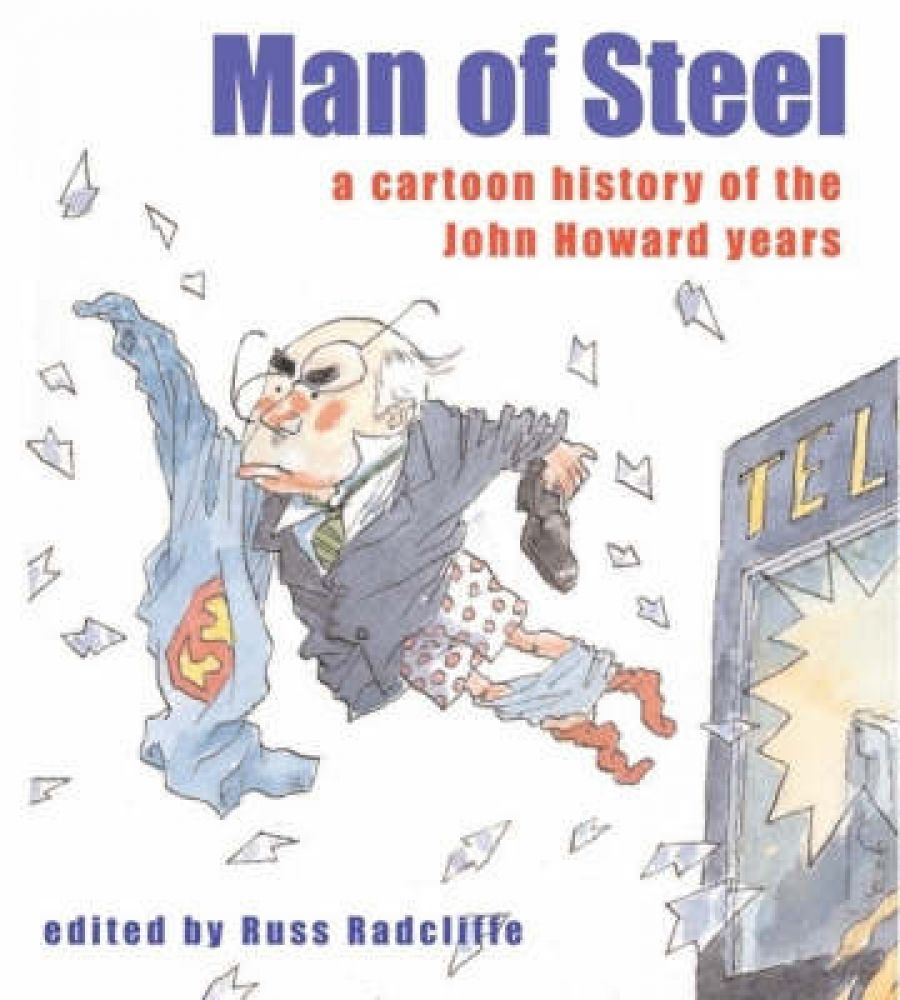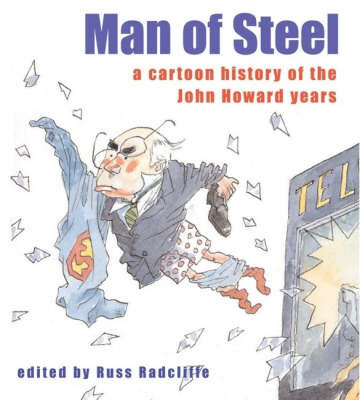
- Free Article: No
- Contents Category: Cartoons
- Review Article: Yes
- Article Title: Good dirty fun
- Online Only: No
- Custom Highlight Text:
If you look carefully at a political cartoon, the most remarkable thing is the quantity of latent information it depends on. Opening Russ Radcliffe’s collection from the Howard years at random, I spot something from one of the nation’s less fabled cartoonists, Vince O’Farrell of the Illawarra Mercury. It is a picture of a military aircraft marked Labor, barrelling along the ground. The pilot has a pointy nose and broad girth, and the co-pilot’s voice bubble tells us, ‘I say skipper … That’s the end of the runway and we still haven’t taken off’. The whole story of Bomber Beazley’s last, tortured term as Opposition leader is there in an image and a couple of words that takes only seconds to assimilate.
- Book 1 Title: Man of Steel
- Book 1 Subtitle: A Cartoon history of the Howard years
- Book 1 Biblio: Scribe, $29.95 pb, 202 pp
- Book 1 Cover Small (400 x 600):

- Book 1 Cover (800 x 1200):

It follows, seemingly, that cartoons are a perfect means of recalling political history. This is true, but only if the reader has the latent knowledge ready to be recalled. It is cruelly possible to imagine a world, not so many years away, where ‘Who was the ALP leader defeated by John Howard at elections in 1998 and 2001, then recalled to the party leadership in 2005?’ becomes a Trivial Pursuit question. Then it will take hundreds, perhaps thousands, of words to make this cartoon intelligible. So it cuts both ways. If you have the knowledge, a cartoon works with remarkable speed, precision and delight. If you lack it, then the joke needs to be explained, and that can be laborious.
Man of Steel depends on the first sort of reading, the delightful focusing of latent knowledge and opinion. It reads like a dream now – I managed to read it with real pleasure on a plane flight at the end of a stupidly long day’s work. At any time between now and the likely fall of the Howard government, it is a delight for anyone with even an amateur interest in Australian politics.
You can be reminded of favourite cartoons, or introduced to brilliant observations from cartoonists who draw for newspapers you don’t routinely read; if you’re not from Canberra, keep an eye out for the Pryors and their pointed analytic power. Not every cartoonist is represented: Leunig, Moir and Warren Brown seem the most notable omissions. Nevertheless, you will be able to extend and deepen your own personal caricature of Howard; he will be fixed forever in your memory as a short man with glasses, eyebrows and a huge bottom lip. You will recall the issues of the decade that delighted or enraged you. You will completely lose touch with any warm emotions you may have harboured towards the fools and knaves who strut the political stage. Especially if you dislike the Howard government, it will all be good, dirty fun.
What this volume lacks is enough apparatus to make sense when the moment (eleven and a half years, and counting) passes. Radcliffe does provide a properly indexed list of cartoonists and their newspapers. It is also handy to have the judiciously selected quotations from contemporary sources such as Hansard and Sky News. But is it too much to ask for the reader of the future to be provided with a bit more narrative support? The minimum should be a date for each cartoon. It could be in miniscule font, so that pedants like me have to get out our magnifying glasses to connect the image to the events of that day. It doesn’t need to be so obvious as to scare off ordinary readers.
There is an assumption that cartoons are self-explanatory, but that is only temporarily true. You can only be sure of that reception on the day, with the rest of the newspaper to provide context. However, even David Lowe’s excoriating cartoon of Hitler and Stalin dancing in agreement to divide up Poland needs a footnote about the Molotov– Ribbentrop Non-Aggression Pact (1939) these days.
As this collection will mostly be bought and enjoyed between now and Christmas, readers will simply know that Howard is short, big-lipped, devoted to the American alliance and dismissive of asylum seekers. For these readers, the experience may even be spiced by the schadenfreude of an election loss. But a cartoon history of the turn of the millennium, properly equipped to unlock the explanatory potential of our fabulous cartooning tradition, will need more contextual information to be of use to the social and political historians of the 2020s. Dates and a dramatis personae for those of us who are already succeeding in the attempt to forget Richard Alston, Peter Reith, Meg Lees, and Mark Latham – is that too much to ask of a history?


Comments powered by CComment